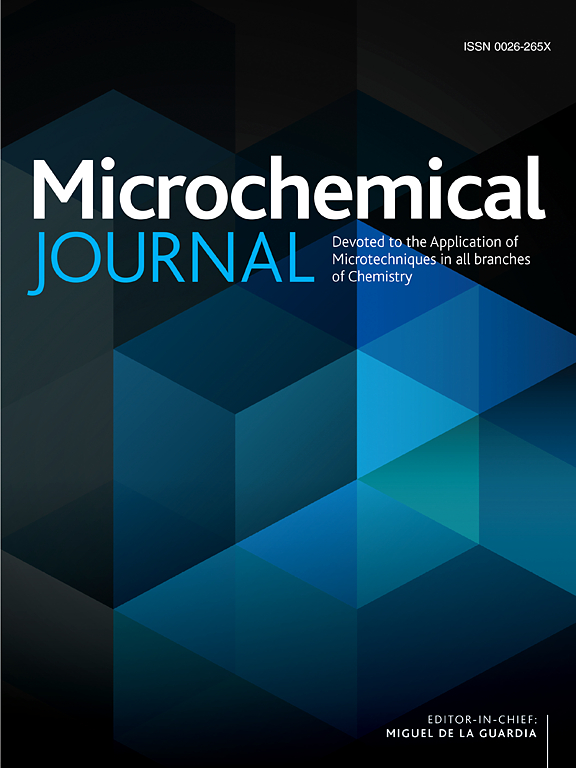Vancomycin-functionalized magnetic bead-qPCR platform for rapid differentiation of viable and dead Listeria monocytogenes in food samples
IF 4.9
2区 化学
Q1 CHEMISTRY, ANALYTICAL
引用次数: 0
Abstract
The present study reports a dual-functional platform that couples vancomycin-functionalized magnetic beads (VMBs) with real-time quantitative polymerase chain reaction (qPCR) to achieve rapid, culture-free discrimination and quantification of live and dead Listeria monocytogenes in complex food matrices. The exploitation of vancomycin's high-affinity binding to the D-Ala–D-Ala motif of intact peptidoglycan enables the selective capture and removal of viable cells, thereby leaving only DNA from non-viable bacteria for SYBR Green qPCR analysis. Optimisation of bead coupling and adsorption kinetics, in conjunction with a pre-calibrated live/dead correction algorithm, yields an LOD of 102 CFU/mL over a 101–107 CFU/mL linear range and completes within 12 h—a process that is significantly faster than conventional culture methods. The validation of the method in beef, salad, cheese, and salmon matrices has yielded recoveries ranging from 96.4 to 99.2 %, with RSDs consistently below 3.6 %. Stability tests have further confirmed that dead-cell DNA remains amplifiable for a minimum of one week, and non-specific capture remains below 5 %. In contrast to isothermal or immunomagnetic approaches, the VMB-qPCR system offers a unique capability to provide unambiguous live/dead resolution without the use of photoactive dyes or extended enrichment, thereby providing a robust, high-throughput tool for food safety surveillance and clinical pathogen monitoring.

万古霉素功能化磁珠- qpcr平台快速区分食品中活菌和死菌李斯特菌
本研究报道了一个双功能平台,将万古霉素功能磁珠(VMBs)与实时定量聚合酶链反应(qPCR)偶联,实现了复杂食物基质中活的和死的李斯特菌的快速、无培养的鉴别和定量。利用万古霉素与完整肽聚糖的D-Ala-D-Ala基序的高亲和力结合,可以选择性地捕获和去除活细胞,从而只留下来自非活菌的DNA进行SYBR Green qPCR分析。在101-107 CFU/mL的线性范围内,优化了头耦合和吸附动力学,结合预先校准的活/死校正算法,LOD为102 CFU/mL,在12 h内完成,比传统培养方法快得多。该方法在牛肉、沙拉、奶酪和鲑鱼基质中的验证回收率为96.4 ~ 99.2%,rsd均小于3.6%。稳定性测试进一步证实,死细胞DNA至少可扩增一周,非特异性捕获率低于5%。与等温或免疫磁法相比,VMB-qPCR系统具有独特的能力,无需使用光活性染料或延长富集,即可提供明确的活/死分辨率,从而为食品安全监测和临床病原体监测提供强大的高通量工具。
本文章由计算机程序翻译,如有差异,请以英文原文为准。
求助全文
约1分钟内获得全文
求助全文
来源期刊

Microchemical Journal
化学-分析化学
CiteScore
8.70
自引率
8.30%
发文量
1131
审稿时长
1.9 months
期刊介绍:
The Microchemical Journal is a peer reviewed journal devoted to all aspects and phases of analytical chemistry and chemical analysis. The Microchemical Journal publishes articles which are at the forefront of modern analytical chemistry and cover innovations in the techniques to the finest possible limits. This includes fundamental aspects, instrumentation, new developments, innovative and novel methods and applications including environmental and clinical field.
Traditional classical analytical methods such as spectrophotometry and titrimetry as well as established instrumentation methods such as flame and graphite furnace atomic absorption spectrometry, gas chromatography, and modified glassy or carbon electrode electrochemical methods will be considered, provided they show significant improvements and novelty compared to the established methods.
 求助内容:
求助内容: 应助结果提醒方式:
应助结果提醒方式:


